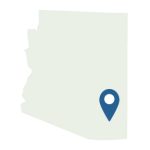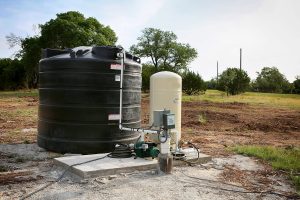By Allison Jermain, RCAC small utility consultant, and Elliott Bochstein, RCAC staff writer
The Groundwater Challenge in Cochise County
Rural Community Assistance Corporation responded to multiple requests for private well assessments from Willcox, a small town in southeastern Arizona’s Cochise County. This largely rural county consists mostly of small towns and unincorporated communities. Agriculture, one of the top industries, uses 90% of the county’s water, and the county relies almost entirely on groundwater. While most residential homes get water from a public water system, those outside towns and water districts depend on private wells for drinking water.
Private well owners’ concerns over groundwater depletion became palpable in recent years; reports of wells running dry and excessive agricultural pumping fuel these fears. The evidence is stark: subsidence, the gradual sinking of land due to overdraft, scars the landscape and damages portions of Highway 191. To keep up, some agricultural wells now plunge over 1,000 feet deep, with price tags reaching hundreds of thousands of dollars. Even for more shallow residential wells, the expense to deepen or drill further to reach dwindling groundwater is overwhelming for homeowners.
Arizona’s Groundwater Management and Citizen-led Challenges
Unlike many other states, Arizona often lacks groundwater management in rural areas. The Arizona Department of Water Resources oversees water usage across the state, but stricter groundwater regulations apply only within established active management areas, or AMAs, and irrigation non-expansion areas – INAs. Currently, there are six AMAs — Prescott, Phoenix, Pinal, Tucson, Santa Cruz and the newly established Douglas — and three INAs: Hualapai Valley, Joseph City and Harquahala.
Cochise County residents took matters into their own hands in 2022, when they submitted petitions to establish two new AMAs matching the Willcox and Douglas basins. The Arizona Water Defenders spearheaded this effort, marking the first time that citizen initiative established an AMA rather than the Arizona Department of Water Resources. The outcome was split: The Douglas AMA, which lies directly south of Willcox, narrowly passed, while a majority vote rejected the Willcox AMA. The results left some residents in the Willcox region deeply concerned about their groundwater supply’s future.

Perhaps also notable is that while an AMA or INA would restrict new agricultural irrigation, most current and historical groundwater usage would be eligible for grandfathered rights. While in some ways limited, AMAs and INAs are the only management instruments available under Arizona groundwater law. Some in Cochise County have argued in favor of local water conservation initiatives rather than what they perceive as mandates from the state. Residents expressed concerns about state-appointed AMA management councils and question whether these would truly represent their agricultural communities’ interests. However, this allows large agricultural operations – including ones based out of state or even transnational firms – to take advantage of the lack of regulation and extract unlimited amounts of groundwater.
RCAC’s Well Assessment: Troubling Results
RCAC private well assessor Allison Jermain conducted six assessments in the Willcox area in response to homeowners’ concerns about declining groundwater levels. She used a sonic well sounder to determine static water levels in the wells and performed water quality testing for all six homeowners. Notably, only two homeowners had prior water quality testing. Jermain provided additional resources, including well guides, treatment information and details on RCAC’s loan and grant program. She also reached out to owners with dry wells, gathered information and offered referrals to RCAC resources.
Of the assessments, four revealed declining static water levels compared to historical measurements. The Willcox Basin’s geography appeared to partly influence this finding. It is a medium-sized basin of nearly 2,000 square miles, characterized by a valley surrounded by medium to high-elevation mountains. The lowest point is 4,100 feet in the Willcox Playa area. Two of the sounded wells in the Playa area showed stable static water levels compared to historical readings. Here, the aquifer materials are sand and gravel with high amounts of clay, and the depth to water is around 50 feet. It is possible that this area has a high replenishment rate from rainfall or from underground flows, although hydrogeology can also vary considerably over short distances.
North and south of Willcox, particularly where agriculture is intense, wells showed a steady drop in static water levels. For example, a well nine miles northwest of Willcox dropped to 225 feet, down from 190 feet in 2012 and 155 feet in 1996. If the 363-foot-deep well continues to decline at this rate, it may have only about 50-60 years of useful life remaining. This observed drop in water level likely stems from overdraft –pumping groundwater faster than it replenishes – and possibly the cone-of-depression effect. This effect occurs when high-capacity agricultural wells draw water from the aquifer, lowering the water table around the well and potentially reducing the water availability for nearby wells. One homeowner expressed concern about a foreign-owned firm’s purchase of 80 acres nearby for vineyards and questioned how this would affect his well in the future.
This finding aligns with the overall declining water levels the United States Geological Survey and the Arizona Department of Environmental Quality monitor in area wells. The Arizona Groundwater Explorer (AGEX) is a new tool that makes this data easily accessible to users. Due to the considerable local, seasonal and annual variation, homeowners should be aware that a sonic well sounder – a tool that uses sound waves to find out how deep the water is in a well – offers only a snapshot of their well’s water level. Additionally, while homeowners were advised to turn off their pumps well before the assessment, pumping and drawdown can influence static water levels, and each well has a unique drawdown rate. To obtain the most accurate data, annual and preferably seasonal readings are necessary.
While well sounders offer a way to measure water levels, it’s important to be aware of their limitations. Obstructions such as root intrusion, or instances where the well casing narrows or changes in size, can affect the reading’s accuracy. Some sounders have a physical sensor on a measuring tape that is lowered into the well, although this method can potentially introduce contamination. Some monitoring wells, on the other hand, permanently installed sensor systems that can take continuous measurements.
Water Quality Concerns and Treatment
Furthermore, the assessments uncovered significant water quality issues. While the water quality generally met basic standards, tests found minor fluoride exceedances in two assessments in the Playa area west of Willcox. The RCAC team immediately informed homeowners and suggested treatment options. Two affordable solutions for rural residents include consumer-grade Berkey fluoride water filters, which can attach to traditional Berkey black filters, and point-of-use reverse osmosis systems. These systems are effective at removing various contaminants, though other water quality parameters can influence their efficiency. While fluoride, often added to water to prevent tooth decay, is safe at levels up to 1.7 mg/L, levels that exceed the maximum contaminant limit of 4.0 mg/L can lead to health issues, such as dental or skeletal fluorosis, arthritis, bone damage and other chronic conditions.
One homeowner experienced symptoms typically associated with excess fluoride consumption. The Environmental Protection Agency’s maximum contaminant limits for various constituents in water are based on health risks and treatment or removal costs; however, establishing a direct causal relationship between a specific contaminant in water and a disease or illness is challenging, given the numerous environmental and genetic factors involved.
Managing Private Wells: Costs and Resources
RCAC staff advised Willcox homeowners to adopt an asset management approach for their water systems, which includes budgeting for future repairs and replacements. In one assessment, Jermain noted that the steel casing and well cap, installed in 1964, showed signs of aging and likely needed replacement soon. As the costs of well repairs, rehabilitation or deepening continue to rise, homeowners should evaluate their water system components based on their average useful life.
For instance, steel casing, which prevents the well hole from collapsing and protects the submersible pump, typically lasts 20-80 years, depending on the water’s corrosivity. In Arizona, where the groundwater is hard but not highly corrosive, steel casings may last longer. Conversely, a standard submersible pump usually lasts about 10 years, and some reach 20 years under low-use conditions. While many private well owners think of their water as free and limitless, unexpected repairs can become costly. Therefore, assessing the cost and useful life of water system components is crucial to prepare for future expenses.
Concerns over declining water levels amid tensions about groundwater use and regulations motivated the private well assessments in the Willcox area. In four out of six assessments, using a sonic sounder confirmed steadily declining groundwater levels. Additionally, two assessments discovered health-based fluoride exceedances, leading to recommendations for treatment options. For four homeowners, assessors also provided their wells’ first-ever water quality results.
RCAC and the Need for Water Solutions
For homeowners with a well that has gone dry or needs rehabilitation, RCAC’s private well loan and grant program offers a potential lifeline. Unfortunately, eligibility for the program is limited to those with incomes at or below 60 percent of the state median household income, which limits its ability to reach many in need.
The stark reality facing communities like Willcox is that unchecked groundwater depletion threatens its future. Combined with the potential for escalating water rights conflicts, these challenges underscore the need for sustainable water management strategies.
In this context, programs like RCAC’s – along with widespread water quality education – are essential tools. Yet the critical question remains: How can communities, policymakers and organizations like RCAC deepen their collaboration to ensure water security for vulnerable rural areas as these vital resources continue to dwindle?
Also in this issue of Network News
HUD Awards over $396,000 to RCAC for Housing Counseling Training Program
Rural Community Assistance Corporation (RCAC) is pleased to announce that it received a $396,246.39 U.S. Department of Housing and Urban Development (HUD) grant. This award is part of HUD’s initiative to distribute $2.75 million in grants to enhance HUD-certified housing counselors’ skills across the country and increase access to professional and effective housing counseling services….
Ari Neumann named RCAC’s Chief Impact and Policy Officer
Rural Community Assistance Corporation (RCAC) named Ari Neumann as Chief Impact and Policy Officer (CIPO) in February. As CIPO Neumann will engage the Chief Executive Officer and Senior Leadership Team, lobbyists, key state and federal industry policy leaders and stakeholders to evaluate, understand proposed policy impacts, goals, strategies and values….

